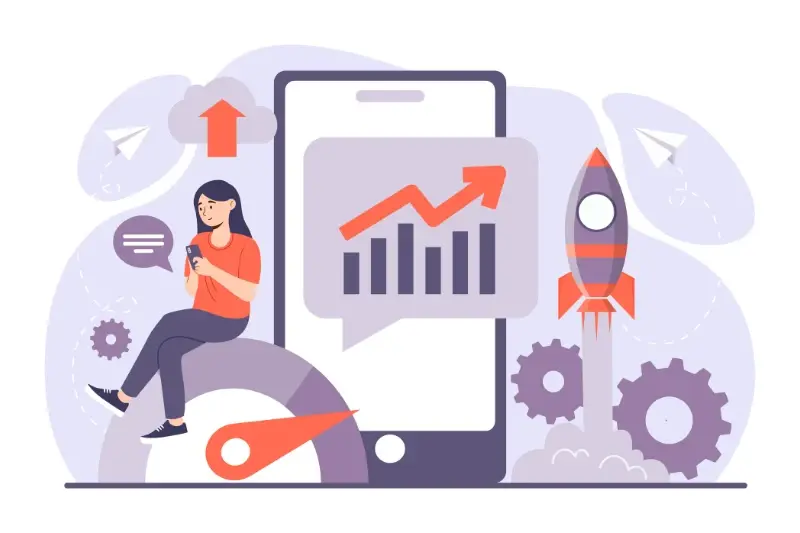Why Vibe Coding Could Be the Future of Mobile App Development
Mobile app development is changing faster than most of us can keep up with. Just when we think we've mastered the latest framework or programming language, something completely new comes along that makes us question everything we thought we knew. Right now, one of the most talked-about concepts in development circles is something called "vibe coding"—and it's starting to turn heads across the industry.
The traditional way of building mobile apps has served us well for years. We write code, test it, debug it, and repeat this process until we have something that works. But what if there was a way to skip some of these steps? What if we could communicate our intentions to the code in a more natural, intuitive way?
The future of programming isn't just about writing better code—it's about writing less code while achieving more
This shift represents more than just another development trend; it's part of a broader evolution in how we approach mobile development. AI programming tools are becoming smarter, development processes are becoming more streamlined, and the line between human creativity and machine efficiency is starting to blur. For those of us who've been in this game for a while, these technology trends feel both exciting and slightly unsettling—but that's often how the best innovations begin.
What Is Vibe Coding and Why Does It Matter
Right, let's get straight to the point—vibe coding isn't about developers sitting around in tie-dye shirts coding to ambient music (though I'm sure some do!). It's actually a development approach that focuses on the feel and flow of coding rather than rigid structures and processes.
Think of it this way: traditional coding follows strict rules, documentation, and procedures. Vibe coding, on the other hand, lets developers trust their instincts and work more intuitively. It's about understanding the rhythm of your codebase and making decisions based on what feels right for the project.
The Core Principles
From what I've observed working with different development teams, vibe coding typically includes these elements:
- Intuitive decision-making over rigid documentation
- Flexible coding standards that adapt to project needs
- Emphasis on developer experience and happiness
- Quick iterations based on gut feelings
- Less formal planning, more experimental approaches
Now, this might sound a bit chaotic—and honestly, it can be if not handled properly. But when done right, vibe coding can lead to more creative solutions and faster development cycles. The key is finding that sweet spot between structure and freedom, which is where things get interesting for mobile app development.
The Problems with Traditional Mobile App Development
Traditional mobile app development has served us well for years, but let's be honest—it's showing its age. The current approach to building apps is time-consuming, expensive, and frankly quite rigid. Most development teams spend weeks or months writing code line by line, testing each feature manually, and then fixing bugs that could have been caught much earlier in the process.
One of the biggest issues is how disconnected the development process feels from the actual user experience. Developers often work in isolation, building features based on technical specifications rather than understanding how real people will interact with the app. This leads to apps that work perfectly on paper but feel clunky or confusing when you actually use them.
The speed problem is real too. By the time a traditional app is built, tested, and launched, market conditions have often changed. User expectations have evolved. Competitors have moved ahead. What seemed like a brilliant idea six months ago might now feel outdated.
Then there's the cost factor. Traditional development requires large teams of specialists—UI designers, backend developers, QA testers, project managers. Each person needs to understand complex programming languages and frameworks. This makes mobile development expensive and inaccessible to smaller businesses with great ideas but limited budgets.
The average mobile app takes 3-6 months to develop using traditional methods, but 90% of apps fail within the first year—often due to poor user experience rather than technical issues.
How Vibe Coding Works in Practice
Right, so you're probably wondering what vibe coding actually looks like when developers sit down to write code. It's not magic—though it might feel like it sometimes! The process starts with developers focusing on the feeling they want users to have rather than jumping straight into technical specifications.
Here's what I mean: instead of writing "create a button that submits form data," a developer using vibe coding might think "make the user feel confident when they're ready to proceed." This shift in mindset changes everything about how the code gets written.
The Step-by-Step Process
The typical workflow looks something like this:
- Define the emotional outcome you want
- Brainstorm what technical elements create that feeling
- Write code that prioritises user experience over efficiency
- Test how the code makes people feel, not just whether it works
- Refine based on emotional feedback
I'll be honest—this approach takes longer initially. You're asking developers to think like psychologists and user experience designers all at once. But the results? They speak for themselves. Apps built this way tend to have higher user retention and better reviews because they actually connect with people on an emotional level.
The real challenge is measuring success. How do you know if your code is creating the right vibe? That's where user research and customer feedback become absolutely critical.
The Role of AI in Vibe Coding
Now here's where things get really interesting—AI programming is what makes vibe coding actually possible. Without machine learning doing the heavy lifting, we'd still be stuck writing every single line of code by hand. I've watched AI tools evolve from basic autocomplete features to sophisticated systems that can understand what you're trying to build just from a rough description.
The AI doesn't just guess what you want; it learns from millions of code examples and development patterns. When you describe wanting a "smooth login flow with social media options," the AI can generate the foundational code structure, handle the authentication logic, and even suggest UI components that work well together. It's like having a development partner who never gets tired and has memorised every programming best practice.
How AI Transforms the Development Process
What makes this approach so powerful is how AI handles the translation between human ideas and machine code. The technology trends show that AI is getting better at understanding context—not just individual requests but how different parts of an app should work together.
The future of mobile development isn't about replacing developers; it's about amplifying their creativity by removing the mundane coding tasks
The development evolution we're seeing means AI can now handle routine functions while developers focus on the creative and strategic aspects of app building. This shift is reshaping how we think about mobile development trends entirely.
Benefits and Challenges of Vibe Coding
Like any development approach, vibe coding comes with its own set of advantages and drawbacks that teams need to weigh up carefully. I've seen firsthand how this methodology can transform projects—but it's not without its complications.
The Main Benefits
The biggest advantage is speed. When developers can focus on the feel and flow of an app rather than getting bogged down in technical specifications, prototypes come together much faster. Teams often find they're more creative too; there's something liberating about building based on intuition rather than rigid documentation.
User experience tends to improve as well. Since vibe coding prioritises how something feels to use, the end result often resonates better with real users. It's quite satisfying when you see people naturally understand your app without needing tutorials or explanations.
The Challenges You'll Face
Communication can become tricky—explaining "vibes" to stakeholders isn't always straightforward! Project scope tends to drift more easily when you're working from feelings rather than concrete requirements. Quality can suffer if team members interpret the vibe differently.
- Harder to estimate timelines and budgets accurately
- Requires experienced developers who can work with ambiguity
- Documentation becomes more challenging
- Client approval processes can get complicated
The key is finding the right balance between creative freedom and structured development practices.
Real-World Examples and Case Studies
Right, let's talk about where vibe coding is actually being used—because this isn't just theory anymore. Several forward-thinking development teams have started experimenting with vibe-based approaches, and the results are quite interesting. GitHub Copilot represents one of the earliest examples; developers describe their intent in natural language comments and the AI programming system generates code that matches their "vibe" or intention.
OpenAI's Codex has been used by mobile teams to rapidly prototype apps by simply describing what they want the app to feel like. One team I know of described wanting "a meditation app that feels like a warm hug" and the AI generated foundational code that captured that emotional essence through gentle animations and soothing colour schemes. The development evolution here is remarkable—we're moving from rigid technical specifications to emotional blueprints.
Early Adopters Making Waves
Smaller mobile development agencies are leading the charge with vibe coding future experiments. They're finding that junior developers can contribute meaningful code much faster when they focus on describing the desired user experience rather than wrestling with syntax. The technology trends show this approach works particularly well for UI components and user interaction flows.
Start small with vibe coding—try using it for simple UI components or user flows before tackling complex backend logic.
The Future Impact on Mobile Development Teams
Let me be honest with you—vibe coding is going to shake things up for mobile development teams, and I'm not entirely sure everyone's ready for it. The way we structure our teams today might look completely different in a few years' time.
Traditional mobile teams have always been quite predictable: you've got your designers, your iOS developers, your Android developers, maybe a backend person or two. Everyone has their lane and they stick to it. But vibe coding changes that dynamic because it blurs the lines between roles.
New Roles and Responsibilities
When AI can interpret creative intentions and translate them into working code, we're going to see some interesting new positions emerge:
- Vibe interpreters who specialise in translating human emotions into technical requirements
- AI prompt engineers who know exactly how to communicate with development AI systems
- Experience curators who focus purely on crafting the right emotional journey
- Human-AI collaboration specialists who bridge the gap between traditional coding and AI assistance
The developers who adapt quickest to working alongside AI tools will likely become team leaders. Those who resist the change might find themselves left behind—and that's the uncomfortable truth about technological progress in our industry.
Conclusion
After eight years of watching mobile development trends come and go, I can say with confidence that vibe coding represents something genuinely different. Not just another framework or methodology that'll be forgotten in six months—this feels like a proper shift in how we think about building apps. The combination of AI programming tools and intuitive development approaches is creating opportunities that simply didn't exist before.
Will vibe coding completely replace traditional development methods? Probably not anytime soon. But it's already changing how teams approach problem-solving and code creation. The development evolution we're seeing isn't just about faster builds or cleaner code—it's about making app development more accessible and creative. When developers can focus on the bigger picture rather than getting bogged down in syntax and repetitive tasks, everyone wins.
The technology trends we've discussed show that this isn't just hype; it's a natural progression. As AI tools become more sophisticated and development teams become more comfortable with these new approaches, vibe coding will likely become standard practice rather than an experimental technique. For mobile development teams willing to adapt, the vibe coding future looks pretty exciting—and that's coming from someone who's seen plenty of "revolutionary" approaches fizzle out over the years.
Share this
Subscribe To Our Blog
You May Also Like
These Related Stories

How Edge Computing Is Revolutionising Mobile App Performance

The Evolution of App Development Trends and Technologies





